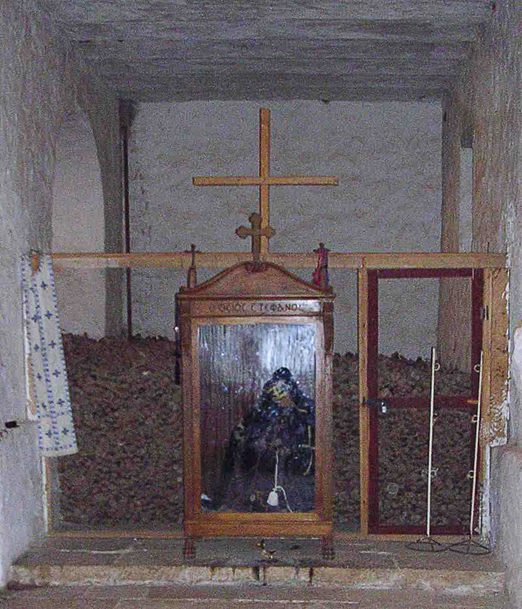
Martin Goodson
Is it Morbid to Think about one’s own Death?
Awareness of one's own mortality has always played a large part in religion and spiritual awakening. It was the reason that propelled Prince Gotama onto the path that led to Buddhahood. This exercise explores the wisdom of memento mori.

Charnel House at Saint Catherine's Monastery, Mount Sinai
About thirty years ago, my hometown in Yorkshire built a new medical centre to cater to the expanding needs of a growing local populous.
However controversy surrounded the completed building when the weather vane was placed atop the roof. A golden-cowled figure holding a scythe had been chosen as the figure for the new flagship centre. There were letters to the local paper and it even made it into some of the national press. Was this a sick joke on behalf of the medical team or the architects? The assumption was that it was the Grim Reaper and people complained about how inappropriate it was to use this figure for a town that was popular with retirees from around the county.
The centre’s PR quickly countered the accusation by saying that it was not the Grim Reaper, it was Old Father Time – who is also depicted as a cowled figure who scythes away at the minutes and hours. I believe it was copied from the well-known representation that features on the weather vane of Lord’s Cricket Ground in London. Symbolically, there’s not much between them. Despite the fact that one appears more benign than the other, they both represent the same basic principle – tempus fugit.
One can understand the controversy and the sense that such a figure was deemed inappropriate for a medical centre, however memento mori – ‘remember that you must die’ was a popular motto during the Victorian age.
Indeed, a gentleman’s study was not complete without a facsimile of a human skull mounted on a wooden stand with the words memento mori on a brass plate around the base.
These days, death is kept away from view by and large, except on the small or big screen where it is generally portrayed as violent, bloody and shocking.
The practice of the deceased being brought back to the family home where, in an open coffin family and friends would come to pay their last respects, has all but died out.
When my late Zen teacher died in 2007, she left explicit instructions that she would be on display in her study for three days before cremation for us all to visit. In fact her students went a step further and arranged a twenty-four hour vigil for the three days, taking it in turn to sit with her corpse for a couple of hours at a time. My slot was during the night. I still remember it because at first I was quite nervous, and had an irrational fear that she would at any moment suddenly sit bolt upright! After about twenty minutes the atmosphere settled and became intensely peaceful. During the next hour or so a couple of problems that had been nagging at me expired in that atmosphere of deathly serenity.
It was the apparition of the impermanence of life and the reality that death comes to all things, which set Prince Gautama on the spiritual quest that led to his awakening under the Bodhi Tree. In fact, remembrance of mortality through loss and bereavement is known as a spur for the worldly to turn inward to seek a more reliable ground upon which to live life. The Zen masters were likewise inspired by remembrance of death, which lead to profound spiritual insight for the likes of Kyogen and Hakuin to name but two.
Back in the 1990s I visited St. Catherine’s Monastery in the Sinai desert. It was the first Christian Orthodox monastery built by the Roman Emperor Justinian I and has been a site for pilgrimage for many centuries. Before entering the monastic grounds to the side of the approach-road one find’s the ossuary. Here the bones of all the monks who have died since the fourth century have been laid to rest. The pilgrims were required to visit the ossuary to see the bones before they entered the monastic grounds and presumably attended the church services. It served as a reminder that no matter who you are, or what your standing in society, or how great or small your problems, both you and they will end up in the same place
Spiritually, far from being considered morbid, remembrance of one’s mortality was used to burst the bubble of self-importance and to diminish the sometimes overweening problems that ‘I’ feel centre around my own being. As my late teacher once suggested, when I am getting myself overwrought I should make a thought experiment to imagine that I have just five minutes left to live. The exercise is to make it a real feeling and then see if that problem still stands up before it.
This is not about ignoring real problems but to cut back on the symptom of ‘I’ that takes things so personally and that stops oneself being able to keep a perspective when navigating the ‘slings and arrows of outrageous fortune.’
……………………




